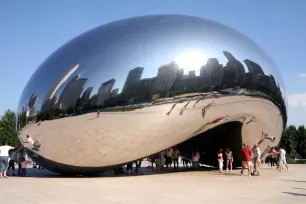Grant Park is Chicago’s principal downtown park. It is located between Michigan Avenue and Lake Michigan. Buckingham Fountain, one of the most famous monuments in Chicago, occupies a prominent site at the center of the park.
History
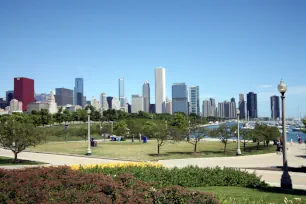
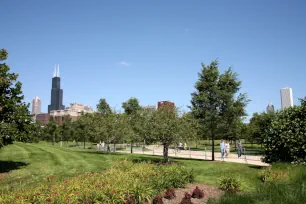
Already in 1836, even before Chicago was incorporated as a city, this lakefront area was set aside as a public ground, free of buildings. In 1847, the area was named Lake Park. Due to erosion, the land was constantly swamped until after the Great Fire of 1871, when much of the debris was pushed into the lake, creating the fill for what is now the actual park.
At the end of the nineteenth century, plans were made to develop the area and construct large buildings and commercial property in the park. But a Chicagoan citizen, Aaron Montgomery Ward, wanted the park to remain open space as had already been decided in 1836, and brought the case to court. After almost twenty years of battle in court, he won the case in 1911. As a result, the park remained open space, offering great views on the cliff of buildings on Michigan Avenue.
In 1901 the park was renamed Grant Park after the eighteenth President of the United States, Ulysses S. Grant. The park’s current appearance goes back to the early decades of the twentieth century, when it was landscaped following the guidelines which were outlined by Daniel Burnham’s 1909 plan for the City of Chicago.
Grant Park has been the site of several historic Chicago events. One of the city’s most notorious events took place here in 1968, when the Democratic Party held its convention in Chicago. A few thousand protesters were brutally attacked by a 16,000 men strong police force. The riots cast a bad light over Chicago and the city’s reputation was heavily damaged.
A much more uplifting historic event took place in Grant Park forty years later, on November 4, 2008, when Barack Obama accepted the post of President of the United States before a crowd of 125,000 people.
Layout
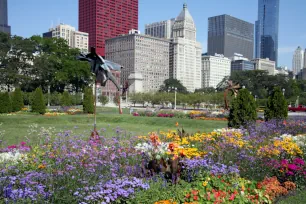
The Park’s structure is based on the French parks with geometric designs. Near Michigan Avenue, a series of bridges cross the Railway tracks that are still on the park’s compound and lead to the actual park which is divided in sections with lawns, wide tree-lined promenades, flowerbeds and monuments, most notably a statue of Abraham Lincoln and the Buckingham Fountain.
Even though the park is 300 acres (121 ha.) large, it can be a frustrating place to walk through as it is bisected by wide strips of busy roads.
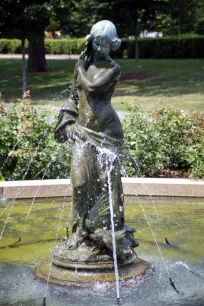
The park is popular nonetheless, especially the front near Michigan Lake, which provides a favorite track for many strollers, joggers and bikers. The large lawns in the park are ideal for festivals. During the summer, Grant Park plays host to a number of events and festivals, such as the Chicago Outdoor Film Festival and the Grant Park Music Festival. Most of the park’s sports facilities are located at the south side of the park, below Balbo Avenue, where you’ll find tennis courts and baseball fields. Other parts of the park are laid out with beautifully arranged flowerbeds, especially near Michigan Avenue, in the Daley Bicentennial Plaza at the park’s northeast corner and around Buckingham Fountain.
Sights
Throughout the park you’ll come across plenty of monuments, statues and fountains.
Buckingham Fountain
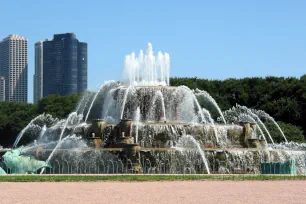
The main attraction in Grant Park is the Clarence Buckingham Fountain. The fountain was commissioned in 1927 by Kate Buckingham to honor her late brother Clarence.
The design of the large fountain is based on the ‘Bassin de Latone’ at the garden of Versailles near Paris and was built by Edward H. Bennett. The Buckingham Fountain is best seen at night, when it is animated with a computerized choreography of color spotlights.
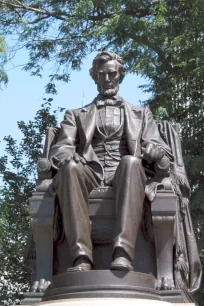
Lincoln Statue
Just northwest of the fountain, across South Columbus Drive, is a statue of a sitting Lincoln. It is one of five statues of Abraham Lincoln – the 16th President of the United States – in Chicago. Lincoln was born in Kentucky, but later moved to Illinois. The statue was designed by Augustus Saint-Gaudens, who was also responsible for the statue of a Standing Lincoln in Lincoln Park. The statue, which was unveiled in 1926, is placed on top of a pedestal. The pedestal rests on a semicircular platform, with a large Doric column on either side of the statue.
More statues and monuments
The park is adorned with many more monuments.
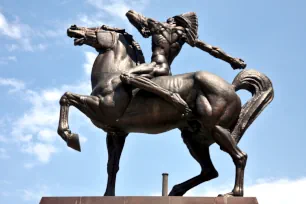
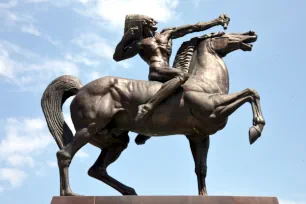
Some of the most notable are the Spearman and the Bowman, 17ft high (5 meter) bronze equestrian statues of Indian warriors. The statues, sculpted by Ivan Mestrovic and installed in 1928, seem to guard the entrance to the park at Congress Parkway. They were erected to commemorate the Native Americans.
South of these two statues is another equestrian statue, set atop a mound near East 9th Street. It was built in honor of John Logan, a civil war general. The monument was created by Augustus Saint-Gaudens and unveiled in 1897.
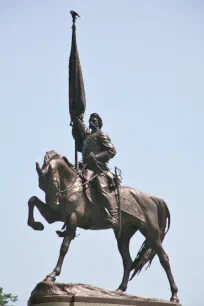
There are also a number of modern monuments in the park. Some are installed temporarily, while others are permanent, such as the group of rusty iron figures known as Agora. The sculpture group is located at the southwestern edge of the park.
Buckingham fountain may be the most famous, but it is not the only fountain in Grant Park. There are several small fountains, such as the four fountains with central figures in the rose gardens near Buckingham Fountain. Another fountain, with an eagle sculpture built in 1931, can be found at the Congress Plaza Garden near Michigan Avenue. A more recent fountain is the Rosenberg Fountain, installed in 1993. The fountain resembles a small Greek temple topped with a bronze statue of Hebe, the goddess of youth.
Many more statues and modern sculptures can be found throughout the park.
Art Institute of Chicago
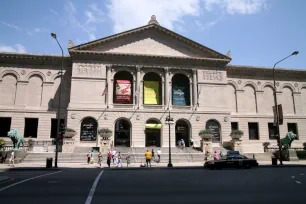
The only building allowed in Grant Park was Chicago’s Art Institute – a museum and school, which in 1893 built its permanent home on the grounds of Grant Park near Michigan Avenue.
The Beaux-Arts Building is home to one of the city’s most popular museums and houses an extensive collection of works of art from around the world. A modern expansion of the museum opened in 2009.
Millennium Park
In 2004, a new, ten hectare (24.5 acre) large park opened as the Millennium Park, essentially expanding the adjoining Grant Park. The new park, bordered by East Monroe Drive, North Michigan Avenue, East Randolph Street and North Columbus Drive, was constructed on top of a desolate rail yard and greatly enhances the neighborhood.
The park includes an outdoor music pavilion, an ice rink and a theater – built below ground – as well as a modern fountain and an iconic monument, the Cloud Gate. A winding, 282-meter / 925-feet-long footbridge designed by Gehry connects Maggie Daley Park with Millennium Park. Another bridge, the Nichols Bridgeway, connects the park with the Art Institute across Monroe Street.
Maggie Daley Park
In 2012 construction started with the aim of transforming a 20 acre (8 ha) section of Grant Park previously known as Daley Bicentennial Plaza into a giant playground. The site, the section of Grant Park east of Millennium Park, is now known as the Maggie Daley Park. There’s loads to do here for the young ones: the park, which opened in January 2015, features an ice ‘ribbon’, a climbing park, a play garden, an enchanted forest and much more.


